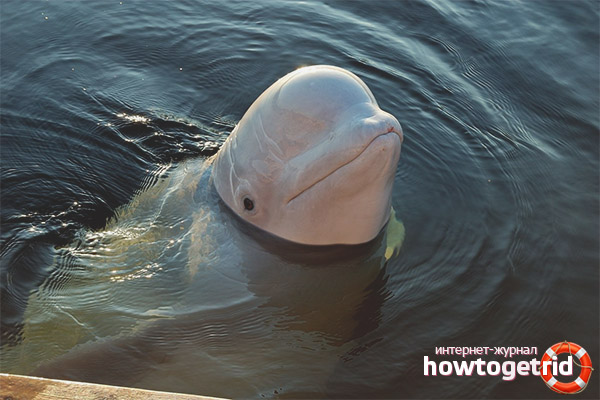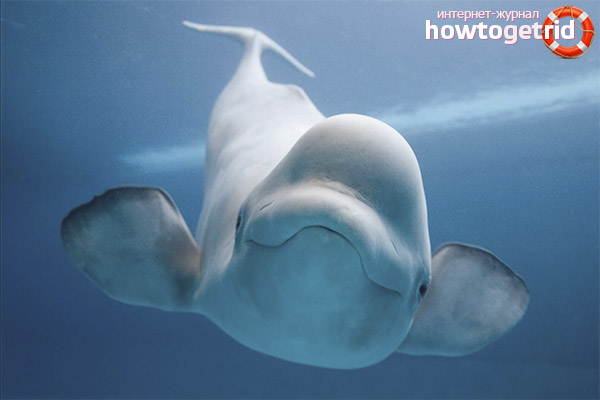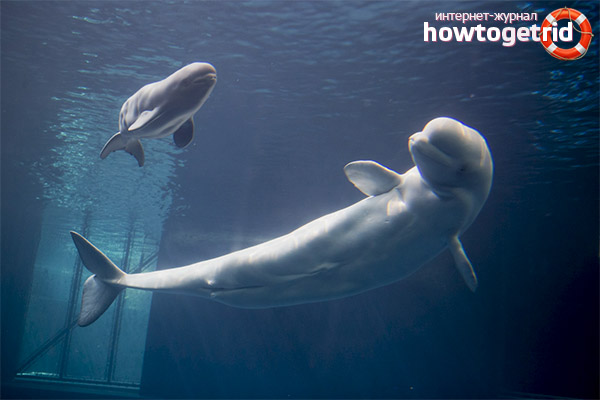The content of the article
What is a whale - a whale or a dolphin? A lot of legends go about this animal. Some sources rank as dolphins, nodding at the external signs. Others stubbornly call the whale, arguing - it is huge! So beluga whales have two names - “singing whale” and “polar dolphin”.
Description and appearance
Beluga whale - refers to a mammal from the family of narwhal, a subspecies of toothed whales, but often because of the places where it lives, is considered a dolphin. There are three species on the territory of Russia - Far Eastern, Kara and White Sea belugas.
The animal of large sizes is up to 6 meters long and weighs about 2 tons. Females are slightly smaller.
The color changes over the years - in newborns, the body color is blue-black, after a year it becomes much paler, acquires a grayish or bluish-gray hue, after three to five years the animal becomes sexually mature, the blueness becomes faded and disappears, belugas become completely white (therefore and call them that). This color is preserved forever.
The head is small, but a large forehead appears on it. Many whales do not know how to rotate their heads, because the vertebrae are one unit - merged together. And in beluga whales they are separated by cartilage, so the whale can turn its head where necessary. The facial muscles are very mobile and the impression is often made that the muzzle expresses some feelings - joy, delight, contempt or indignation.
The pectoral fins are not very large, oval. The beluga has no dorsal fin. Because among the ice, this detail may be superfluous and will interfere.
The skin is very thick (up to 2 centimeters) and strong, underneath there is a fat layer, the thickness sometimes reaches up to 15 centimeters, which serves as an animal thermal insulation.
Habitat, character
Lifestyle
Belugas are flock animals. A flock consists of groups. The groups are different - in one the female and her offspring can live, in the other - several adult males. The whole life of belugas is seasonal migration, depending on the time of the year.
In winter, when the coastal part is ice-bound, belugas go deep into the sea, where there is less ice and there are ice-free areas where you can swim and get fresh fish enough. If the frosts are very strong, they move to the southern regions. In the spring they return closer to the coast.
Belugas, like other dolphins, are very attached to the place where they were born, and annually return there.
Food
The diet of beluga whales is very rich, but the main dish is fish, which are kept in schools - cod, herring, flounder, tuna, capelin. She especially loves salmon - she’s ready to go anywhere for this fish. It is in pursuit of salmon that the beluga often swims in rivers.
The method of catching and catching fish is truly whale: water, along with prey, is absorbed inside, food is swallowed, and water is erupted back into the ocean.
Belugas are excellent hunters, and they get food by gathering in a group of 4-5 individuals. By such combined efforts, animals drive their prey into small areas, where they catch it.In addition to fish, many types of worms, crustaceans, and mollusks serve as food.
Reproduction and children
Males become sexually mature at 7 years old, females much earlier - at 4 years old. The mating season lasts depending on the habitat - from mid-April to June. Usually, for peaceful pleasures, quiet places on the coast are chosen. During mating games, males literally fight for the attention of the female, arranging real fights in the water. The female chooses the winner as a partner, and then the mating takes place.
Pregnant females form groups in which they hold the entire period of pregnancy until they give birth. They give birth in the coastal zone in warm waters. Usually one cub is born, although sometimes (but extremely rarely) there are twins. After 13-14 months, a small dolphin is born. Childbirth occurs with the tail forward. Its length up to one and a half meters, immediately, having been born into the light, the baby emerges to the surface and takes the first breath. A mother feeds her large cub (up to 80 kilograms at birth) with milk, and does this for a long time - from one to two years.
Enemies
Belugas in nature have only two main natural enemies. The killer whale is the most dangerous on the water. The beast is hardy and fast, swims much faster than a beluga whale, so there is practically no chance to hide from it, being far from the coast. As a rule, in such pursuits, when the killer whale catches up with a whale, the whale is defeated and becomes a victim.
The second enemy is the polar polar bear. During the wintering period, the predator catches belugas in the coastal waters near the ice hole and, when the whale emerges for the next portion of life-giving air, the shaggy predator kills the animal with a paw blow, providing itself with fatty, nutritious food for a long time.
Another enemy can be called a person. Toxic wastes discharged by enterprises into ocean and sea waters adversely affect animals. Because of this, schools have to migrate very far, where animals simply freeze.
Habits

Belugas have good vision - they can see well both under water and above it, but they prefer to navigate in the water column using signals issued in the ultrasonic range - they understand from the returned echo that there is a barrier or a school of fish ahead. But besides this, belugas can make up to fifty very loud sounds: here there can be the twittering of birds, squeaks in a variety of tones, screaming, rattle, whistling, other sounds reminiscent of a growl. Sounds, like most animals, are used for communication between group members. They learned to use facial expressions for the same purpose.
Molting
In the spring, belugas begin to molt - old skin comes off them, replaced by new ones. Belugas participate in the shedding process very actively - crawl out to land and rub against coastal pebbles and pebbles, helping the peel to peel off. She slides in large flaps.
Man and beluga whale
Due to the ingrained habit of beluga whales to migrate along the same routes, whales used to be easy prey for whale hunters. The animals were driven into the shallows, about which they were crashed. In a similar cruel way, several hundred of these individuals were destroyed. Or they used other methods - for example, they blocked the movement with nets and nets. They hunted because the whales were famous for soft meat, strong strong skin, high-quality whale fat and the so-called whalebone.
In the modern world, hunting is prohibited, the animal is listed in the Red Book.
Differences of beluga whales from other whales
- Beluga whales can be tamed and trained. This is what people use when creating dolphinariums, where dolphins live in conditions as close as possible to the natural environment. With the help of trainers, they learn various tricks and arrange performances. They are also taught to shoot underwater, which helps in the exploration of the Arctic.
- Belugas are not only good hunters, but also excellent divers.Only under water, these whales cannot spend much time - no more than 10-15 minutes. They need to emerge every few minutes to the surface in order to stock up with the next portion of air.
- In order to maintain normal functioning, adult belugas must eat at least 15 kilograms of food per day.
- Sometimes belugas fall into ice captivity, but with an ice thickness of not more than 7 centimeters, animals easily pierce it with a strong back.
- Belugas migrate collectively and gather in colonies, sometimes huge - up to a thousand individuals.
- Belugas know how to swim not only on their stomachs, like most fish, but also on their backs. They also manage to swim their tail forward well.
- The speed with which the beluga whale usually swims is 4-10 kilometers per hour. But a frightened whale develops significantly greater speed - up to 22 kilometers per hour.
- They live in nature for 30-35 years, but in dolphinariums this period is longer by 5 10 years.
Often, these whales are called “sea canaries” because of their ability to sing and make different sounds. For the same reason, the expression "roaring beluga" went.
Video: beluga whale (Delphinapterus leucas)












Submit